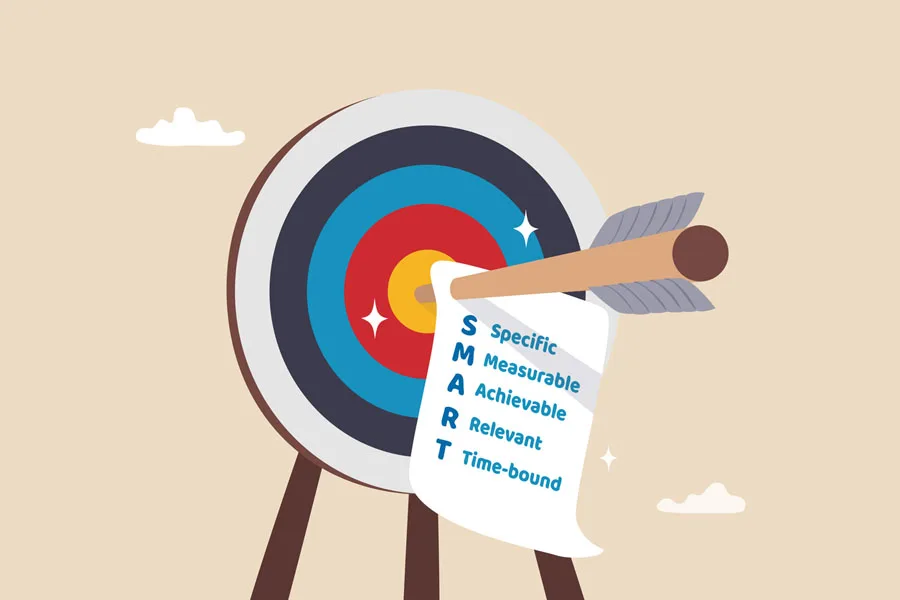Setting goals is essential for growth and progress; however, not all goals are equal. To maximize effectiveness and ensure success, it’s crucial to set SMART goals—Specific, Measurable, Achievable, Relevant, and Time-bound goals.
Here, we’ll delve into each component of SMART goals and provide a comprehensive guide on how to set them for your business.
Table of Contents
What are SMART goals, and why are they effective?
How to set SMART goals
Example of effective SMART goal setting
Challenges and solutions
Final thoughts
What are SMART goals, and why are they effective?

SMART goals provide a structured and practical framework for setting and achieving objectives, promoting clarity, accountability, and success in business endeavors. SMART is an acronym for specific, measurable, achievable, relevant, and time-bound.
SMART goals are effective for several reasons:
- Clarity: By providing a clear framework, SMART goals help individuals and teams understand exactly what is expected of them.
- Focus: SMART goals help prioritize efforts by directing attention toward specific objectives and preventing distractions and wasted resources.
- Accountability: The measurable and time-bound nature facilitates accountability, as progress can be easily tracked and evaluated.
- Motivation: SMART goals provide a sense of accomplishment as milestones are achieved, motivating individuals and teams to continue working towards larger objectives.
- Adaptability: SMART goals can be adjusted or revised as circumstances change, allowing flexibility in response to new information or challenges.
How to set SMART goals
Now that you know what SMART goals are, here are the steps to take to set them:
- Identify your objectives: Start by defining what you want to achieve. Clearly outline your goals, whether it’s increasing revenue, expanding your customer base, or improving operational efficiency.
- Make them specific: Drill down into the specifics of each goal. Instead of a broad goal like “improve customer satisfaction,” specify what aspects you want to improve and why.
- Set measurable targets: Determine how you will measure progress and success; this could include metrics such as sales revenue, website traffic, customer retention rate, or employee productivity.
- Ensure they’re achievable: Assess whether your goals are realistic, given your resources, capabilities, and market conditions. If a goal seems too ambitious, consider breaking it into smaller, more manageable milestones.
- Review for relevance: Ensure that your goals are aligned with your business objectives and contribute to your overall strategy. If a goal doesn’t directly support your long-term vision, reconsider its importance.
- Establish deadlines: Set specific deadlines or timeframes for achieving each goal. Whether it’s a short-term objective to be accomplished within a few weeks or a long-term goal to be achieved within a year, having a deadline creates accountability and urgency.
- Track progress and adjust as needed: Regularly monitor your progress towards each goal and make adjustments as necessary. If you’re falling behind, identify potential obstacles and take corrective action. Conversely, if you’re exceeding expectations, consider setting new, more ambitious goals.
Example of effective SMART goal-setting
Let’s consider an e-commerce business in the tech industry specializing in selling consumer electronics and gadgets. Here’s an example of how they could set SMART goals:
Objective: Increase online sales and market share
Specific
- Goal: Increase online sales revenue by launching a new line of smart home devices and promoting them through targeted marketing campaigns.
- Why: To capitalize on the growing demand for smart home technology and expand our product offerings.
- Who: The marketing and product development teams will spearhead this initiative.
Measurable
- Target: Increase online sales revenue from the smart home device category by 25% within the next six months.
- Metrics: Monitor sales revenue, website traffic, conversion rates, and customer feedback on the new product line.
Achievable
- Resources: Allocate sufficient budget for product development, marketing, and advertising campaigns.
- Skills: Utilize the expertise of the product development team to design innovative smart home devices.
- Market analysis: Conduct market research to identify consumer preferences and ensure product-market fit.
Relevant
- Alignment: Launching smart home devices aligns with our business strategy of offering innovative tech products and diversifying our product range.
- Industry trends: Smart home technology is a rapidly growing market segment, presenting significant opportunities for growth and market expansion.
Time-bound
- Deadline: Launch the new line of smart home devices and commence marketing campaigns within the next three months.
- Milestones: Track progress regularly and adjust strategies as needed to meet the six-month target of a 25% increase in sales revenue.
Challenges and solutions
Setting SMART goals can be a powerful strategy for businesses, but they also come with challenges. Here are some common challenges that businesses may face when setting SMART goals, along with potential solutions:
1. Lack of clarity
- Challenge: Sometimes, businesses struggle to define specific and clear goals, leading to ambiguity and confusion among team members.
- Solution: Conduct thorough research and analysis to clearly understand what needs to be achieved. Involve key stakeholders in the goal-setting process to ensure alignment and clarity. Use concise and specific language when articulating goals to eliminate ambiguity.
2. Unrealistic expectations
- Challenge: Setting overly ambitious goals that are unrealistic or unattainable can demotivate employees and lead to frustration.
- Solution: Conduct a realistic assessment of resources, capabilities, and market conditions before setting goals. Break down large goals into smaller, more manageable milestones to create a sense of progress and achievement. Set stretch goals that challenge employees to push their limits while remaining achievable with effort and commitment.
3. Lack of buy-in
- Challenge: If employees are not fully committed to the goals or do not understand their importance, it can be challenging to achieve them.
- Solution: Communicate the rationale behind each goal and how it aligns with the company’s overall vision and objectives. Involve employees in the goal-setting process to increase ownership and accountability. Provide regular updates on progress and celebrate achievements to maintain motivation and momentum.
4. Inadequate measurement and tracking
- Challenge: Without proper metrics and tracking mechanisms, it can be difficult to measure progress and determine whether goals have been achieved.
- Solution: Identify key performance indicators (KPIs) and establish clear metrics to track progress towards each goal. Implement systems and tools to collect and analyze data effectively. Regularly review and evaluate progress against established benchmarks and make adjustments as needed. Note: If you’re struggling to find KPIs to track, your goal may not be specific enough.
5. Lack of flexibility
- Challenge: Business environments are often unpredictable, and goals may need to be adjusted in response to changing circumstances or new information.
- Solution: Build flexibility into goal-setting processes to accommodate unforeseen challenges or opportunities. Regularly review and reassess goals to ensure they remain relevant and achievable. Encourage open communication and collaboration among team members to adapt goals as needed and stay agile in response to changes.
By addressing these common challenges proactively and implementing practical solutions, businesses can maximize the effectiveness of their SMART goals and drive greater success in achieving their objectives.
Final thoughts

Setting SMART goals is a powerful strategy for business growth and success. Making your goals Specific, Measurable, Achievable, Relevant, and Time-bound creates a roadmap for success and ensures that your efforts are focused and effective.
Whether you’re a startup, a small business, or a large corporation, incorporating SMART goals into your planning process can help you stay on track and achieve your objectives.



